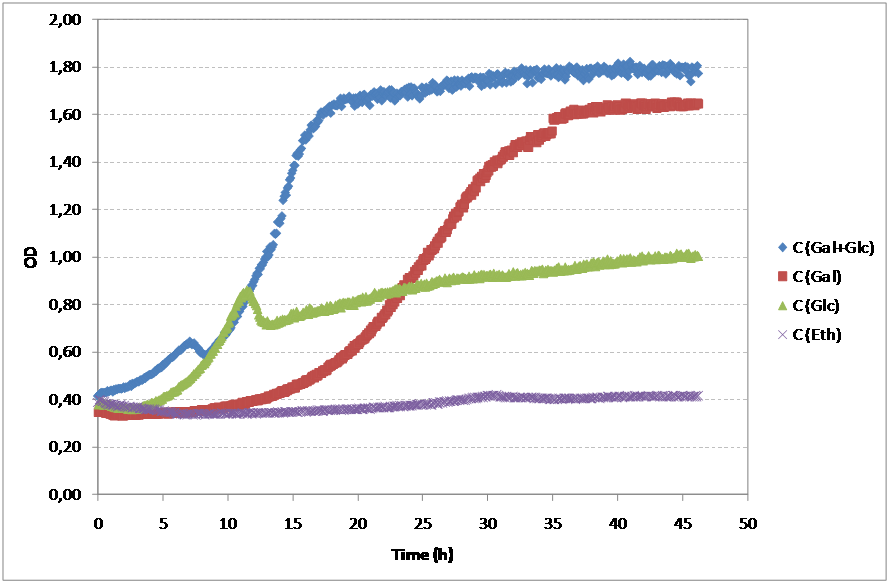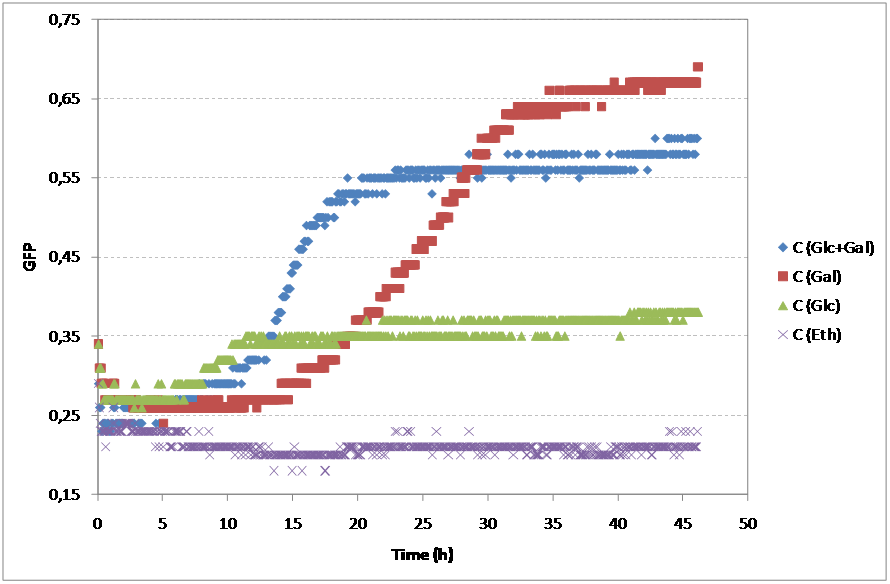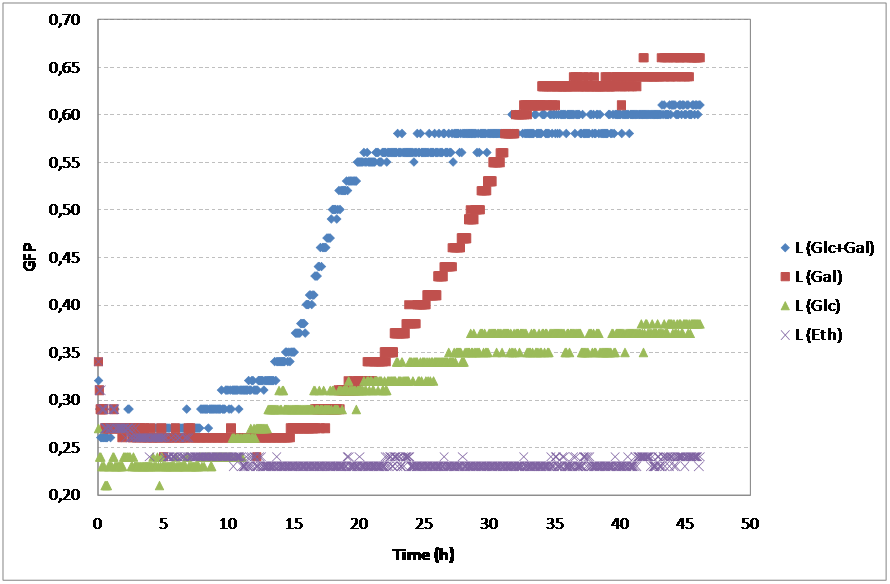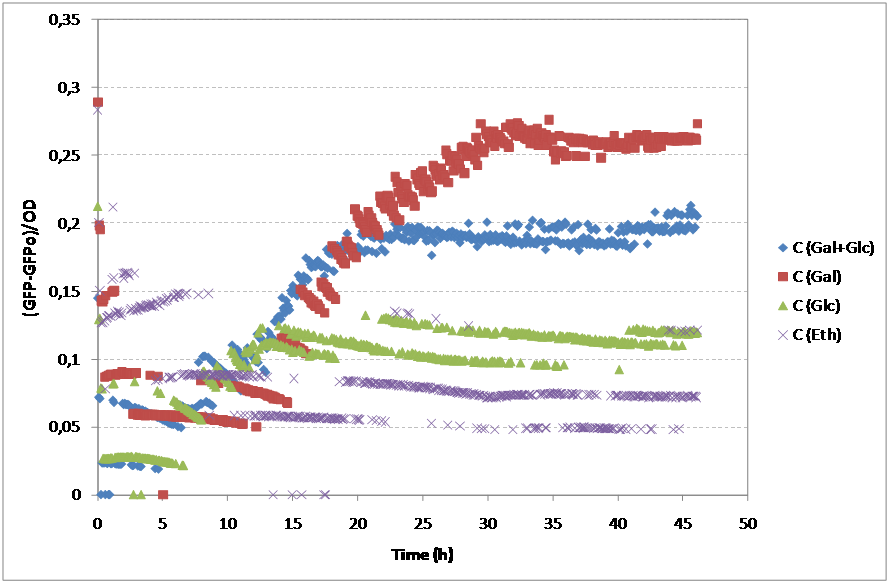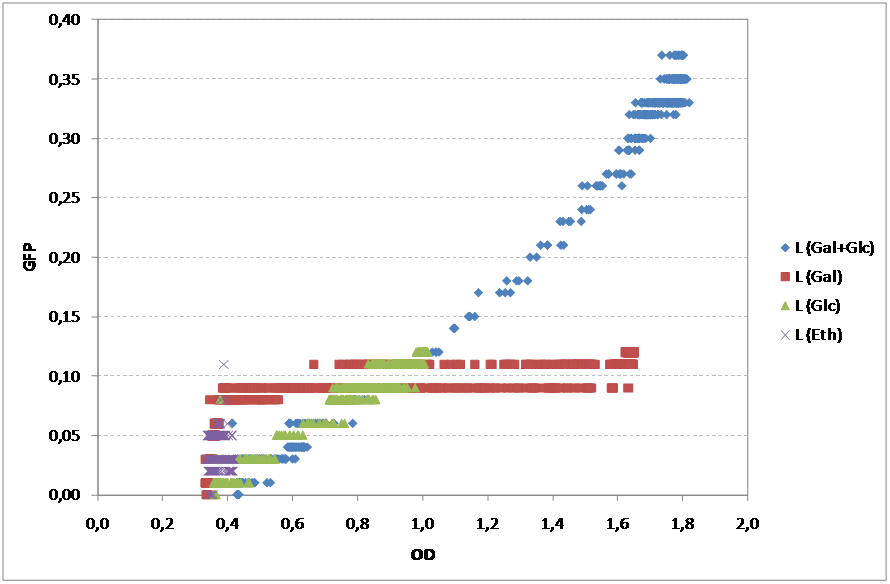Team:DTU Denmark/results
From 2009.igem.org
| Line 232: | Line 232: | ||
</table><br><br> | </table><br><br> | ||
| - | As expected, both strains showed different profiles of growth accordingly to the substrate. For Glucose and Galactose, the growth curve showed two exponential phases, the first one corresponding to the growth on Glucose and the second corresponding to the growth on Galactose. Although the initial OD was similar in both cases, the growth on Galactose showed an even longer lag phase than the glucose. Finally, as expected, the substrate reporting less growth was ethanol. For the Redoxilator, the growth solely on Glucose showed a longer lag phase compared to the mixed substrate, probably due to a lower initial OD.<br><br> | + | <p align="justify">As expected, both strains showed different profiles of growth accordingly to the substrate. For Glucose and Galactose, the growth curve showed two exponential phases, the first one corresponding to the growth on Glucose and the second corresponding to the growth on Galactose. Although the initial OD was similar in both cases, the growth on Galactose showed an even longer lag phase than the glucose. Finally, as expected, the substrate reporting less growth was ethanol. For the Redoxilator, the growth solely on Glucose showed a longer lag phase compared to the mixed substrate, probably due to a lower initial OD.</p><br><br> |
| Line 243: | Line 243: | ||
<html><br> | <html><br> | ||
| - | Regarding the GFP signal, all substrates showed different profiles. Nevertheless, the fermentative substrates, Glucose and Galactose, showed higher values of GFP than the respirative substrate, Ethanol.<br><br> | + | <p align="justify">Regarding the GFP signal, all substrates showed different profiles. Nevertheless, the fermentative substrates, Glucose and Galactose, showed higher values of GFP than the respirative substrate, Ethanol.</p><br><br> |
</html> | </html> | ||
| Line 252: | Line 252: | ||
<html><br><br> | <html><br><br> | ||
| - | Although these results are accordingly to what was expected, it is important to mention that these cultures didn’t have comparable growths, so, in order to subtract this variability of the growth, one should normalize the GFP expression with OD. Additionally, to the GFP values, the residual values for each case were subtracted.<br><br> | + | <p align="justify">Although these results are accordingly to what was expected, it is important to mention that these cultures didn’t have comparable growths, so, in order to subtract this variability of the growth, one should normalize the GFP expression with OD. Additionally, to the GFP values, the residual values for each case were subtracted.</p><br><br> |
</html> | </html> | ||
Revision as of 18:19, 21 October 2009

| Home | The Team | The Project | Parts submitted | Modelling | Notebook |
|
The redoxilator - Genetic design - Applications and perspectives - Results - Safety considerations The USER assembly standard - USER fusion of biobricks USER fusion primer design software - Abstract - Instructions - Output format |
The project Results Two strains were grown under diferent substrates, Glucose, Galactose, Glucose and Galactose and Ethanol. These two strains that we denominate Redoxilator and Leaky correspond to the redoxilator with a constitutive promoter and a minimal promoter repectivelly. Growth rates (h-1) obtained for the two strains on diferent carbon sources
As expected, both strains showed different profiles of growth accordingly to the substrate. For Glucose and Galactose, the growth curve showed two exponential phases, the first one corresponding to the growth on Glucose and the second corresponding to the growth on Galactose. Although the initial OD was similar in both cases, the growth on Galactose showed an even longer lag phase than the glucose. Finally, as expected, the substrate reporting less growth was ethanol. For the Redoxilator, the growth solely on Glucose showed a longer lag phase compared to the mixed substrate, probably due to a lower initial OD.
Regarding the GFP signal, all substrates showed different profiles. Nevertheless, the fermentative substrates, Glucose and Galactose, showed higher values of GFP than the respirative substrate, Ethanol.
Although these results are accordingly to what was expected, it is important to mention that these cultures didn’t have comparable growths, so, in order to subtract this variability of the growth, one should normalize the GFP expression with OD. Additionally, to the GFP values, the residual values for each case were subtracted.
|
Achievements
Redox sensing device |
| Comments or questions to the team? Please Email us -- Comments of questions to webmaster? Please Email us |
 "
"

